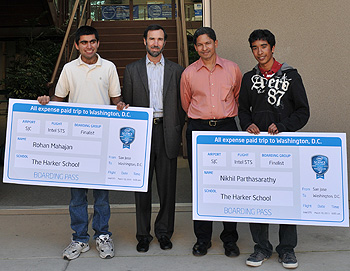Two high-school students mentored by UC Santa Cruz professors are finalists in the nationwide Intel Science Talent Search competition. They are both students at the Harker School in San Jose, the only school in the country to produce two finalists (out of a total of 40 nationwide).
Finalists Nikhil Parthasarathy and Rohan Mahajan were among four Harker semifinalists who did summer research internships at UCSC in 2010. Parthasarathy studied the structures of distant galaxies under the guidance of postdoctoral researcher Kamson Lai and Sandra Faber, University Professor and chair of astronomy and astrophysics. His project title is "A Morphological Analysis of z~3 Lyman Break Galaxies in the Hubble Ultra Deep Field." Mahajan investigated the use of solar cells to generate hydrogen fuel under the guidance of Yat Li, assistant professor of chemistry and biochemistry. His project title is "The Effect of Doping on CdS Sensitized Ti02 Nanowires for Photoelectrochemical Hydrogen Generation."
A total of 15 high school students took part in UCSC's summer internship program coordinated by Puragra Guhathakurta, professor of astronomy and astrophysics. Guhathakurta organized the summer internship program last year after mentoring three Harker students in 2009, one of whom was a finalist in the Intel competition. (The other two were semifinalists.)
"It was very gratifying to see the program grow so rapidly from 2009 to 2010," Guhathakurta said. "The students are amazingly bright, motivated, and hard working. They jump right into their projects and are ready to drink from the fire hose. It comes as no surprise that the students are proving to be successful on a nationwide scale in these science competitions. This is wonderful recognition of the excellent academic preparation that goes on in these high schools and the world-class scientific research that gets carried out at UCSC."
The Intel Science Talent Search encourages talented U.S. high school seniors to pursue independent research in science, math, engineering, and medicine. Finalists will gather in Washington, D.C., for a week-long event in March. They will undergo a rigorous judging process, meet with national leaders, interact with leading scientists, and display their research at the National Geographic Society. The top winner will receive $100,000 from the Intel Foundation.


